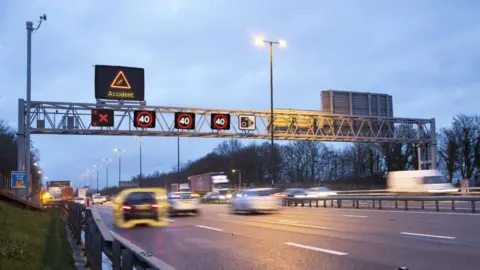Smart motorway deaths: Coffins protest planned
 PA Media
PA MediaCampaigners are set to carry 38 coffins across London to the Department for Transport headquarters to demand smart motorways are scrapped.
The protest has been organised by Claire Mercer, widow of Jason Mercer, who was killed on the M1 near Sheffield in 2019 when he was struck by a lorry.
Mrs Mercer said the coffins represented the number of official deaths on smart motorways between 2014 and 2019.
The Department for Transport said more safety measures were being introduced.
Mrs Mercer has campaigned against the use of smart motorways since her husband's death, and said the protest - planned for 1 November - aimed to raise awareness.
"I've now been fighting this campaign for two years," she said.
"I started with legal action, the judicial review, and that's still going on - it's just taking so long."
 Other
OtherAccording to the Local Democracy Reporting Service, a recent investigation by the Daily Mail found that more than one in 10 safety cameras was either broken, misted up or facing the wrong way, and the Department of Transport ordered an inquiry into the revelations.
"When did we get to the point where we review safety after [smart motorways] have been running for years?" Mrs Mercer said.
"It's not good enough. More and more people are going to die, and what worries me is that it will be a coach full of children."
 Gov.uk
Gov.ukCampaigners are due to march from the London Eye to Parliament Square, then on to the Department for Transport's head office on Horseferry Road.
In response, a spokesperson for the Department for Transport said: "Every death on our roads is a tragedy and our thoughts remain with anyone who has lost a loved one.
"While data shows that fatalities are less likely on smart motorways than on conventional ones, we know some drivers can feel less safe on them."
They added that any new "all lane running motorway" would be required to have additional safety measures in place, such as technology to detect stopped cars.
Smart motorways, which use technology to maintain the flow of traffic and give information on overhead displays, have existed in England since 2002.
The all-lane-running version, which involves opening the hard shoulder permanently to drivers, began in 2014.
Another version uses a "dynamic hard shoulder", which opens and closes to traffic depending on congestion.

Follow BBC Yorkshire on Facebook, Twitter and Instagram. Send your story ideas to [email protected] or send video here.
